World War II Posters, Office of War Information, Record Group 44: Records of the Office of Government Reports, National Archives.
Incredibly, some American POWs managed to survive the Japanese massacre at Camp 10-A near Puerto Princesa, Palawan on December 14, 1944.
At nightfall some of those who somehow survived wandered into the jungle and others attempted to swim across Puerto Princesa Bay. Radioman 1st Class Joseph Barta spent 10 days hiding in the jungle and evading Japanese patrols, before being safeguarded by guerrillas. Marine Private First Class Glenn McDole hid in the camp garbage dump.
Captured after the fall of Corregidor, Marine Sergeant Rufus W. Smith had been with McDole when they escaped out a hole at the back of their shelter, after one of the medics, who was on fire, warned them what was happening. Smith recalled that nine men made it to the beach from that trench, but only he and McDole survived. Japanese search parties looked for survivors. Two Japanese patrol boats roamed the beach and “were shooting at anybody and anything that moved.”
Smith recalled that “there were men on fire and being shot and bayoneted” as he crawled back up the cliff and stayed “under a bunch of overlapping grass and weeds.” After the four men hiding below Smith’s position were killed, Japanese soldiers lined up and bayoneted the grass every few feet looking for survivors. Smith added, “One of them stepped on me, but the bayonet missed me, so, again, I got by okay.”
In the evening after everything quieted down, Sergeant Smith heard the Japanese count of 149 killed. He believed that he was the only one left alive. As “soon as it got good dark,” he eased down the cliff and then into the water, swimming under the water as far as he could.
Marine Sergeant Douglas Bogue recalled, “I took refuge in a small crack among the rocks, where I remained, all the time hearing the butchery going on above.” He observed that “the stench of burning flesh was strong.” Sergeant Bogue concluded, “By the Grace of God I was overlooked.”
A handful of survivors of the massacre swam across the bay to the Iwahig Penal Colony. The distance was about five miles, but battling the current in the bay, some had to swim farther. They were naked and exhausted, weak and delirious. Army Private First Class Eugene Nielsen had been shot twice and was badly cut up. Swimming “somewhere around midway or beyond,” Marine Sergeant Rufus Smith had been bitten by a shark on his arm and shoulder, but he managed to get “loose from him.” Running into an old fish trap, Smith rested briefly, avoiding a Japanese patrol boat, and then continued his swim across the bay. Albert Pacheco and Edwin Petry had hidden in a cave. Petry later reported, “The crabs ate on us pretty good down there.” When the high tide forced them out, they too swam the bay.
Reaching the far shore, they stumbled through the swamp. Nielsen ran across a Filipino wielding a bolo knife, who offered him water. Nielsen told him, “I think I am the only one alive from the Palawan prison camp.” The man replied, “You have friends here.” The Filipino led him to a jungle hideout used by local guerrillas.
When Nielsen got to the hideout, he discovered that the guerrilla group had already located Pacheco and Petry. Over the course of the next few days they located a couple more Americans. Glenn McDole made the swim after three days of hiding; exhausted, he had been clinging to a fish trap in the bay until he was picked up by a sympathetic fisherman who called, “Hey, Joe, you a POW?” McDole answered, “I was, but no longer.”
After swimming the bay, Smith rested on the beach for hours hoping to regain his strength before continuing inland. Starting out, he “stumbled and fell a lot, [and] tore a lot of skin off me.” He spotted a shack on the side of the mountain near the boundary of the Iwahig Penal Colony, and he worked his way to it, figuring that he would “find some friends there.” He encountered Filipinos and noted, “Six of them got together, and they convinced me they were friendly.” He recalled that he started to relax after one of them pulled a .45 caliber pistol and then pitched it to him. They also fed him, treated his wounds, and got him clothes, hospital pajamas, to wear.
The guerrillas belonged to the Palawan Special Battalion. Guerrilla organizations in the province initially formed in 1942 when the Japanese landed after the fall of Corregidor in May 1942. The Japanese did not occupy the entire island and, instead, established garrisons at Puerto Princesa and in the villages along the provincial highway. The Japanese pattern was to control the towns and send out patrols to other parts of the province on foot and by boat, often during harvest to seize rice.
In response to the arrival of Japanese troops, the lightly-armed Philippine Constabulary in the province dispersed to the hills and began to organize, initially in a company of about 80 riflemen. Other units arose during the occupation ranging from miners armed with clubs, pistols, and makeshift grenades to a group near Puerto Princesa led by a Philippine Commonwealth Army Reserve officer who was also the former provincial governor. At first there was a mixed degree of cooperation between the groups. Then, in late 1942, General Douglas MacArthur’s General Headquarters (GHQ), Southwest Pacific Area (SWPA) tasked the various guerrilla elements to fuse, becoming part of the Sixth Military District located on Panay, and “to build an intelligence net.” Then in 1943, the guerrillas on Palawan were consolidated and reorganized in 1943 as the Palawan Special Battalion, part of the 65th Infantry Regiment, Sixth Military District.
The Sixth Military District gave the battalion two major missions. The first was intelligence gathering to “give us fresh, accurate and fast enemy information.” To do so, the battalion was tasked to organize operatives in different parts of Palawan Province, inducting them into the Army just like its other enlisted men. The second mission was to organize a rifle battalion, calling to arms all available enlisted men and reservists and deploying them to cover important towns.
With new direction, and to meet the organizational requirements, the Palawan Special Battalion grew quickly. In September 1943, the battalion strength was 31 officers and 268 enlisted men. By late 1944, the battalion under the command of Major Pablo P. Muyco consisted of 57 officers and 1058 enlisted men. The Palawan Special Battalion was organized into a battalion headquarters, four geographically oriented infantry companies, and supporting medical, transportation, signal, boat, and military police elements more typically associated with a regiment. The guerrillas, whether recruited by or inducted into the battalion, were considered members of the Philippine Army, serving with the Armed forces of the United States. They were paid in what was considered to be guerrilla or emergency currency.
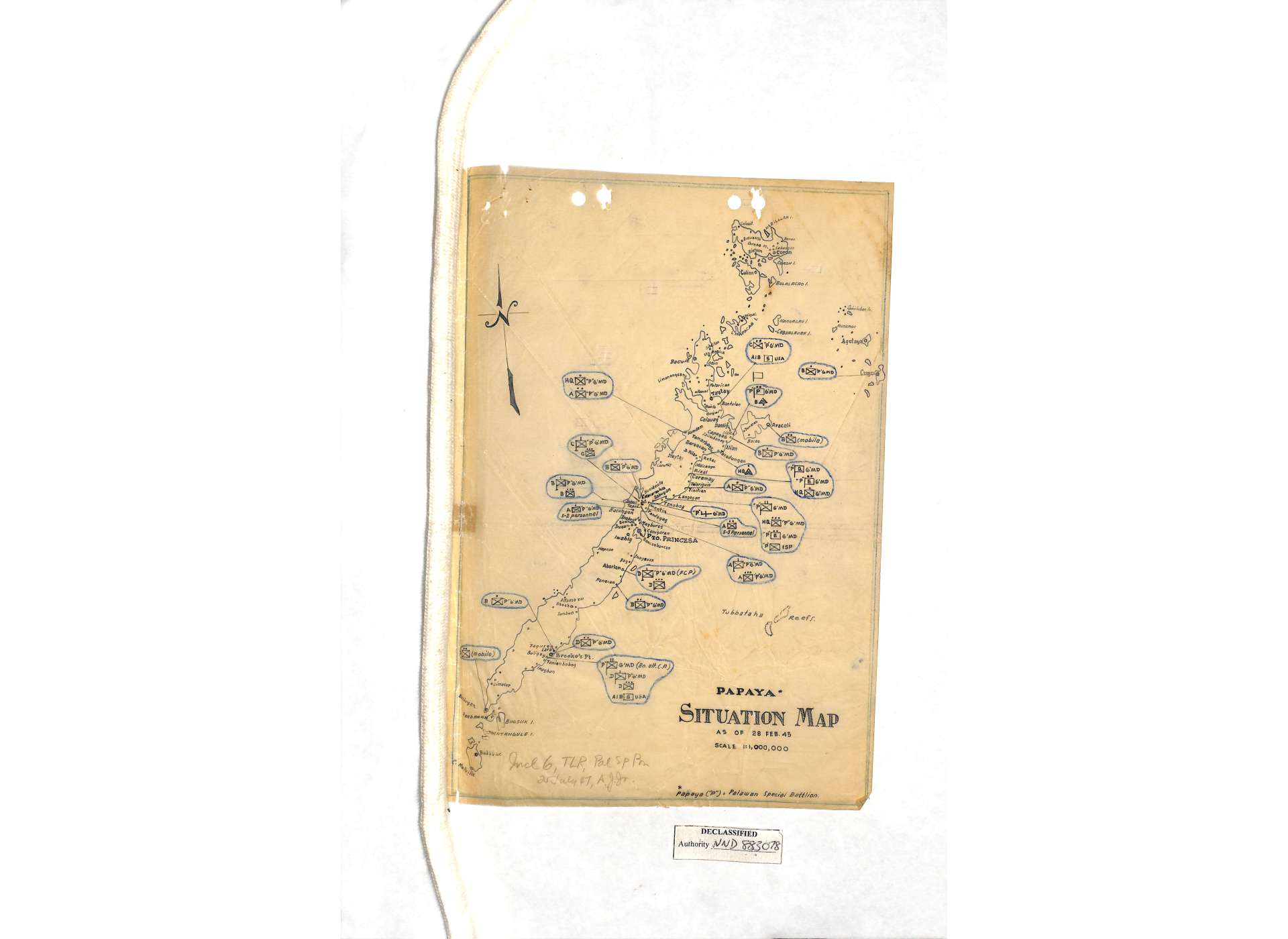
Situation overlay depicting the disposition of the elements of the Palawan Special Battalion in February 1945. Guerrilla Unit Recognition Files, Record Group 407: Records of the Adjutant General's Office, National Archives.
As the battalion grew and developed its capability, it increasingly became a concern for the Japanese garrison. In May 1944, the Palawan Special Battalion informed its headquarters,
“The Japanese military authorities in Palawan have announced in no uncertain terms their determination to exterminate all armed resistance in this Province. We have seen this announcement were [sic] not idle words.”
Although ammunition was in very short supply, by all accounts, guerrilla morale was good, particularly as the Allied return to the Philippines seemed increasingly likely. Elements were tasked with keeping constant track of enemy movements. The battalion’s military police and S-2 section monitored the traffic and movement of people in the province.
In September 1944, Major Muyco prescribed that provisions be stockpiled for periods of inclement weather, and presumably for anticipated operations in the future. He also directed implementation of a continuous training program, giving priority to rifle marksmanship, squad and platoon combat tactics, scouting and patrolling techniques, operational discipline, guerrilla tactics, and intelligence reporting. He also established regular reporting procedures from the battalion to Sixth Military District for unit strength and situation reports. Those reports, after evaluation by the Sixth Military District headquarters, ultimately would be relayed to MacArthur’s GHQ, SWPA.
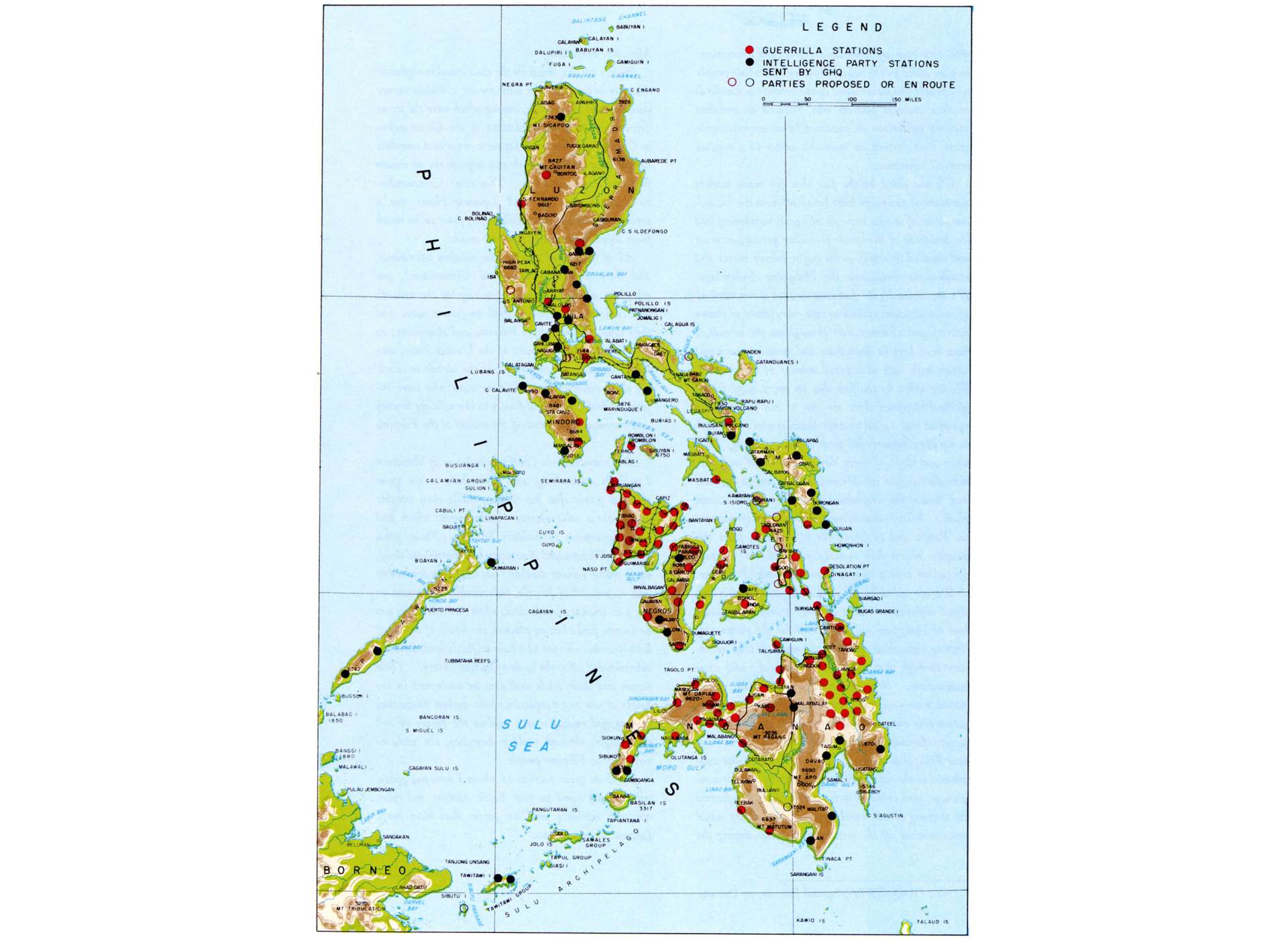
The extensive Philippine general radio net developed during the Japanese occupation for reporting and intelligence collection, as of October 1944. Guerrilla stations are depicted in red, and intelligence party stations dispatched by General Douglas MacArthur’s General Headquarters (GHQ), Southwest Pacific Area (SWPA) are in black.
Courtesy of the US Army, Reports of General MacArthur: The Campaigns of MacArthur in the Pacific, Vol. 1, Plate 93
After Christmas 1944, the battalion sent a “flash” message to the Sixth Military District headquarters providing an initial report of the massacre and announcing that a few American POWs had survived and were safe with the guerrillas. The description of the massacre provided in that report captured the chilling character of the Japanese war crime.
“On the [after]noon of 15 Dec. ’44 shortly after the morning raid by 2 American Planes at Puerto [Princesa], all the American PW were shoved inside a barbed wire enclosure by 50 Japanese soldiers under one officer. Shortly thereafter, several Japanese soldiers entered the enclosure with several cans of gasoline and started pouring gasoline on the prisoners. After they were all soaked with gasoline they started to burn them. Many of the prisoners tried to fight their way out and fought stubbornly. Others tried to escape through the barbed wire but the Jap soldiers with their pieces, sabers and daggers started shooting, stabbing and clubbing those who tried to escape and those who were fighting for their way out battling for their life. Those whose clothes caught fire had just a moment of furious struggling [before] they succumb[ed]. Those who were shoot [sic], stabbed and clubbed to death were burned just like the rest who never had the strength anymore to struggle from the infernal grave. Until this date only five American prisoners of war are known to have escaped this terrible holocaust.”
Several aspects of the message, however, contributed to it being treated as an unverified initial report at higher headquarters. The report set low expectations for its veracity with the assessment that “there is more probability that it is true” than not, noting that details came from unspecified people who recently arrived from Puerto Princesa. Concerning the four Americans who had crossed the bay to the Iwahig Penal Colony, the report declared that this “is not yet verified” despite the fact that those four were already safely in guerrilla hands and enroute south to Brooke’s Point and another was receiving medical attention. The characterization as unverified certainly left some of the key facts open to question. The victims of the massacre had been in air raid trenches, which were doused with fuel, rather than being doused directly at the start of the attack. The report also incorrectly noted that the massacre occurred on December 15, a day after the actual event, complicating potential verification because of the relationship of events in the camp to the flight of two American P-38s over the camp that day.
Meanwhile, guerrillas of the Palawan Special Battalion infiltrated six Americans on foot and by outrigger canoe about 25 miles south to Brooke’s Point. Brooke’s Point had been the primary sector of one of the guerrilla companies on Palawan and also served as the battalion’s alternate command post.
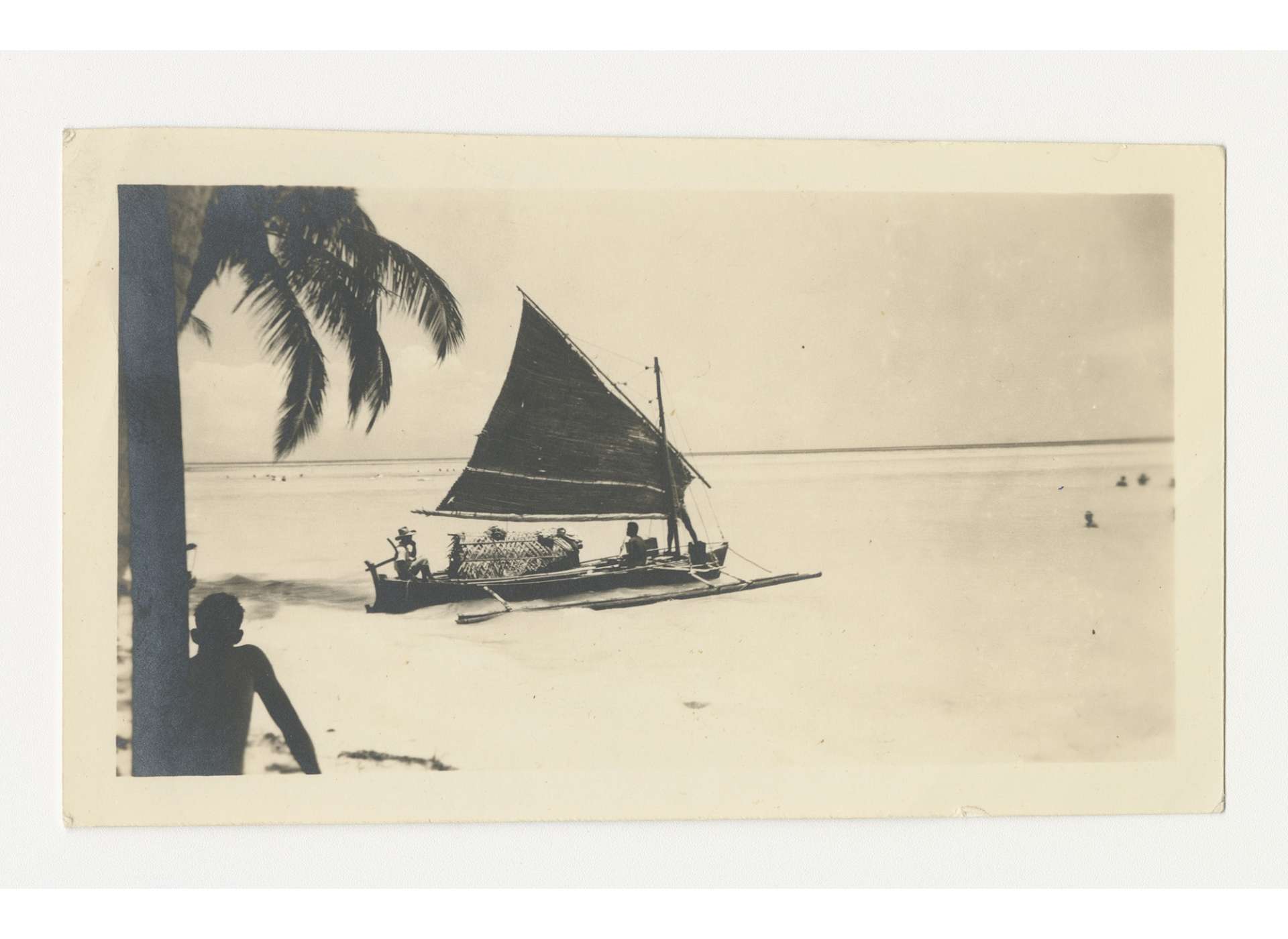
A wartime photo of a native outrigger canoe with a thatched-grass sail on Palawan. An outrigger similar to this helped guerrillas of the Palawan Special Battalion transport former-POWs about 25 miles south to the base at Brooke’s Point.
Filipinos in an outrigger canoe with a thatched-grass sail on Palawan, 1945. Gift in Memory of John O. Spinks, Sr., from the Collection of The National World War II Museum, 2011.018.067.
It likely was the beginning of January 1945 before the Palawan Special Battalion’s flash report reached General Douglas MacArthur’s headquarters with news that the guerrillas were safeguarding American POWs who had escaped from a potential Japanese massacre. MacArthur’s Deputy Chief of Staff for Intelligence, G-2, Major General Charles A. Willoughby dispatched aircraft to bring the half dozen survivors to Allied lines and safety.
A US Navy PBY Catalina Flying Boat with a fighter escort linked up with the guerrillas at Brooke’s Point, Palawan on January 6. They picked up six Americans who escaped from the POW camp on Palawan. Added to the manifest was another American who had remained in the Philippines since 1898, and whose son-in-law led the local guerrilla unit. The PBY flew the seven Americans 850 miles over Japanese-held territory to Morotai, an island south of the Philippines in the Dutch East Indies.
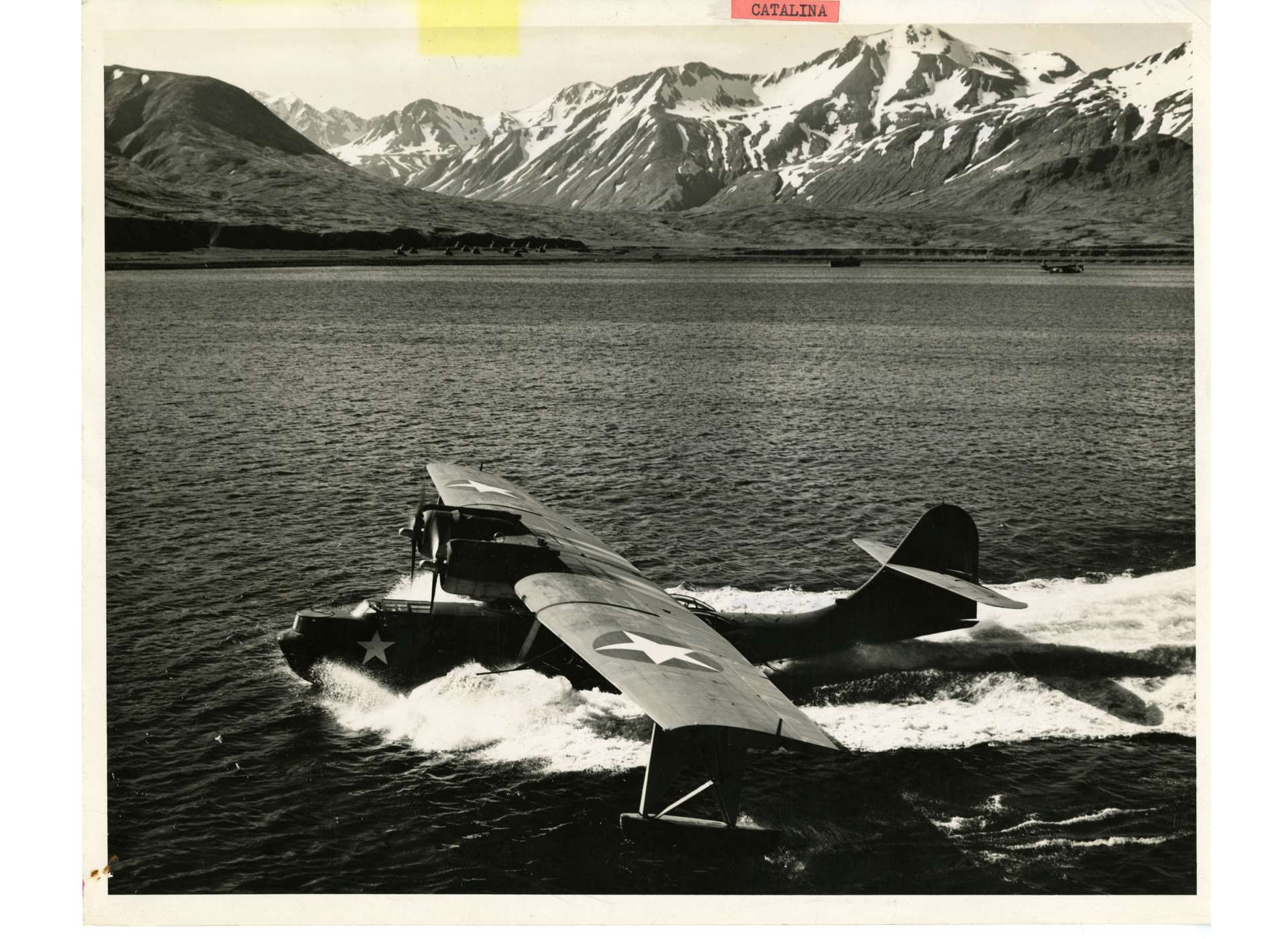
A PBY Catalina Flying Boat glides in for a landing. A similar aircraft was dispatched to Brooke’s Point, Palawan to fly seven Americans 850 miles over Japanese-held territory to General Douglas MacArthur’s headquarters on Morotai, an island south of the Philippines in the Dutch East Indies. US Navy Official Photograph, Gift of Charles Ives, from the Collection of The National World War II Museum, 2011.102.434.
In time, five other Americans were safely recovered by Filipino guerrilla forces, after having been delayed by jungle, Japanese military activities, wounds, and bad weather. They would also be picked up and brought to Allied installations.
The survival and return to Allied territory of those 11 men was a testament to their tenacity, Filipino guerrilla forces and their intelligence network, coast watchers and relays with long range radios, and the submarines, PT boats, and PBYs that transported them to safety.
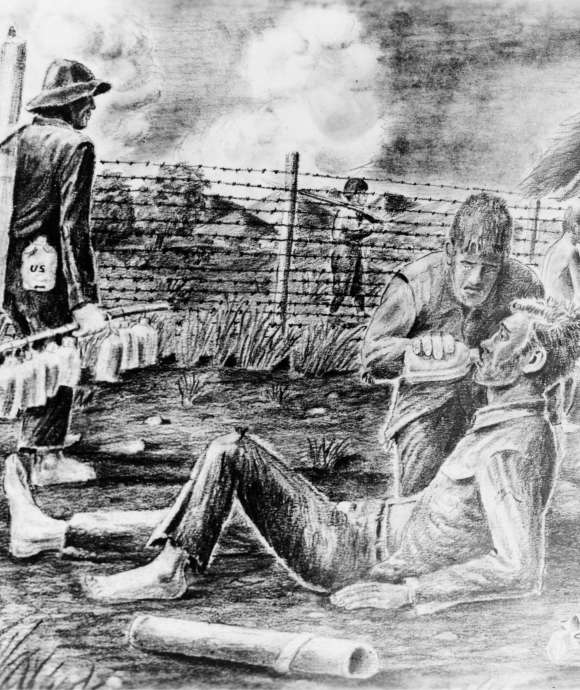
Part 1: ‘Dispose of the Them’: Massacre of American POWs in the Philippines
As the Allied liberation of the Philippines was underway, Japanese commanders acted on orders to annihilate American POWs rather than allow them to assist enemy efforts, and in December 1944 cruelly executed 139 American POWs on Palawan.
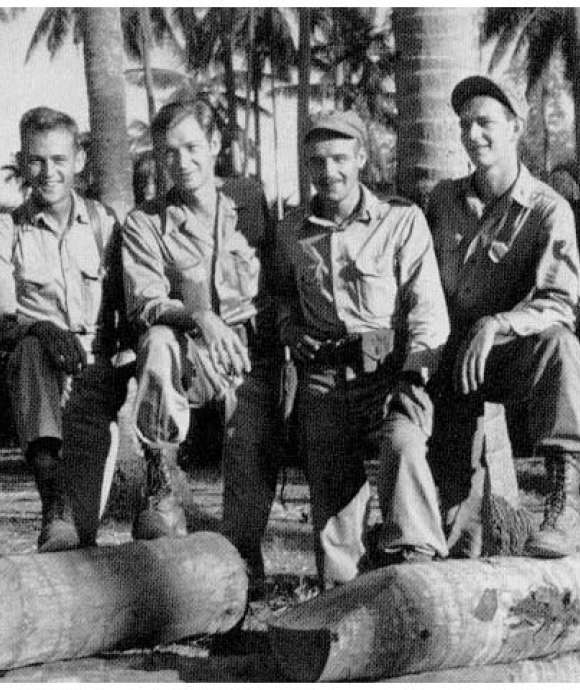
Part 3: Call for Action and Liberation in the Philippines
As General Douglas MacArthur’s campaign on Luzon was underway, news of the Palawan massacre produced a call to action to save thousands of Allied POWs and civilian internees from a similar fate. With the extraordinary assistance of Filipino guerrillas, four daring raids were launched behind Japanese lines to liberate those camps.
Michael S. Bell, PhD
Mike Bell is the Executive Director of the Institute for the Study of War and Democracy.
Cite this article:
MLA Citation:
APA Citation:
Chicago Style Citation:
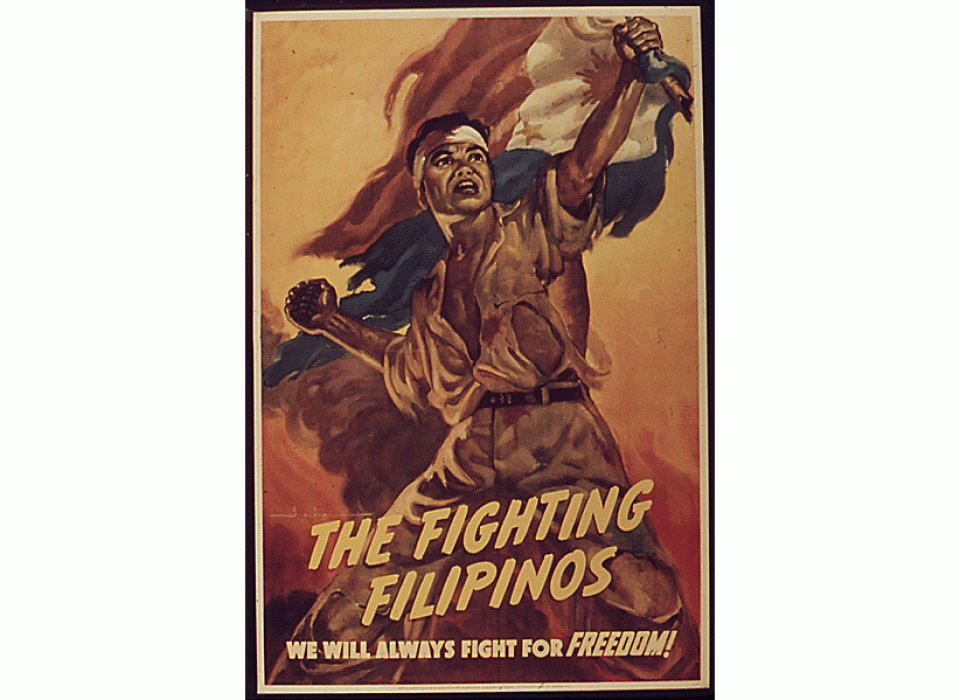






![Max Fuchs, New York City cantor, sings as Rabbi Sydney [sic] Lefkowitz, Richmond, VA, conducts the first Jewish services from Germany.](/sites/default/files/styles/max_650x650/public/2025-10/image1.jpg)

